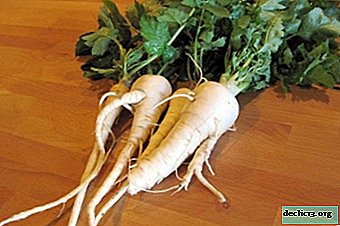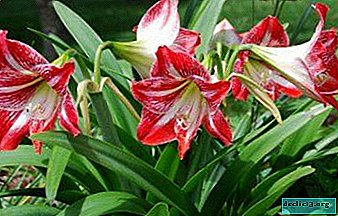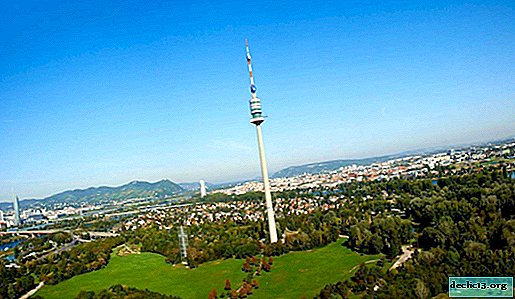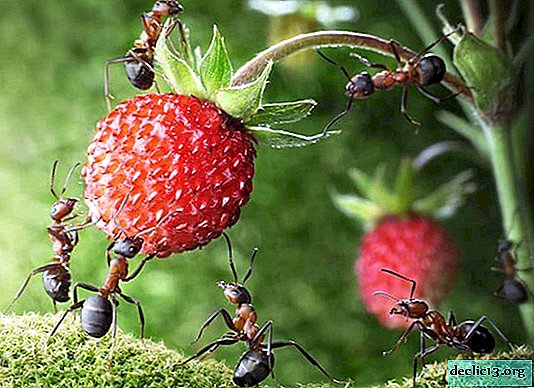Features and agricultural technology of growing parsnips in the open ground. Prevention of possible problems

In Russia, parsnip was somewhat forgotten, but in the last decade, this vegetable began a "new life." Due to the sweet-spicy taste, it is increasingly used for cooking original dishes. This vegetable is also popular in the medical industry (it is useful for the digestive and nervous system, and is also used as a diuretic, painkiller, tonic).
At home, the parsnip root can be fried, stewed, baked, boiled, frozen. Greens are dried or used raw as seasoning.
How to correctly choose a plant variety?
There are many varieties of parsnip, which differ from each other in the color of the root crop, size and taste. Therefore, in order to make the right choice, you must first decide how you will use it.
- If you plan to add raw to salad or prepare main dishes, then it is better to take the Hormone variety. Its flesh is white, dense and fragrant.
- For confectionery, choose "Gladiator" or "Guernsey", because of the sweet taste.
- Harris Model is better to put in mashed soup, it has a very soft structure and is well-digested. You do not need to add flour or starch.
- In medicine, the variety "Petrik" is most often used. It is resistant to disease and has good yield.
In addition, all varieties can be divided according to the ripening time of the root crop.
| Early ripening (up to 120 days) | The average ripening period (120-140 days) | Late ripening (more than 140 days) |
| Round | Petrik | Guernsey |
| Cook | Best of all | Student |
| Boris | Gladiator | |
| Hormone | Delicacy | |
| White stork | Heart |
The most popular varieties are "Round" and "Best of all". They have high productivity (up to 4 kg per 1 sq.m.) and are relatively unpretentious - they are grown throughout Russia.
Step-by-step instruction: how to grow a vegetable?
The following describes agricultural techniques and methods for cultivating plants in open ground.
Through seedlings
 When the goal is to get fruits as soon as possible or just a long spring, gardeners prepare parsnip seedlings.
When the goal is to get fruits as soon as possible or just a long spring, gardeners prepare parsnip seedlings.
- In addition to the ground, a little sand is added to the seedling cups to make the soil looser.
- Seeds are planted at a distance of 2 cm from the surface and watered abundantly with water.
- Seedlings need to be kept under the lamp for 14 hours a day at a temperature of +20 degrees.
- After a month, the sprouts are ready for transplantation into the open ground.
The best place for a parsnip is where potatoes, carrots, tomatoes grew before it. The soil should be loose and fertile.
Parsnip root is a very moisture-loving vegetable. Therefore, it must be regularly watered abundantly and loosen the earth in order to prevent stagnation of water.
Parsnip is fed in 4 stages:
- A week after transplanting seedlings. Use high nitrogen fertilizer.
- After 2 weeks, repeat the procedure.
- In mid-summer, fertilizer with phosphorus and potassium is used.
- The final dressing with the same fertilizer is done after 3 weeks.
This feeding option will not be needed if the soil was well fertilized the previous fall.
Sowing seeds directly into the soil
Parsnip seeds are planted in open ground in mid springwhen the air has already warmed up to +15 degrees.

- Before sowing, it is recommended to hold them for a while in wet gauze or cotton so that they sprout. You can use water with a growth activator diluted in it. This is because the parsnip sprouts slowly and not all seeds will be taken in dense soil.
- On the excavated territory, grooves of 2-3 cm deep are made. The distance between them should not be less than 20 cm, so that the fruits do not interfere with weeding and growth of each other.
- Seeds are poured in continuous strips into pre-moistened soil and covered with soil.
When planting, you can use ash diluted in water with minerals.
Good effect on the seedling rate by coating the sown area with a film (and cups with seedlings). But you need to raise it once a day for 20 minutes.
After germination of the sprouts, the first thinning and weeding is done. The distance between the leaves is 5 cm. During the second thinning, when the sprouts have reached 10 cm, the distance between them increases to 15 cm.
Parsnip leaves contain an enzyme that, with active sun, can cause burns on the skin. Therefore, weeding is best done in the morning or evening and only with gloves.Mistakes during landing and care and how to overcome them?
- Seeds for planting in any way should be fresh. To be sure of the quality of the seeds, you can grow them yourself. For this, several root crops are left in the ground for the winter, which in the spring are spudded, watered, weeded and loosened the earth around. When the plant's umbrellas turn brown, it's time to collect the seeds.
An important point is drying. With proper processing, the seeds retain the ability to bear fruit for 1-2 years.
- Due to poor germination, many seeds need to be taken.
- Before sowing in open ground, you need to thoroughly clean the soil from weeds and roots.
- Lack of soil moisture. During drought, the soil is compacted and prevents the root crop from growing (sprouting seeds, sprouting sprouts). In addition, with a lack of water, the plant goes to the arrow.
- For feeding, you can not use manure. Parsnip is suitable only for liquid fertilizers. For example, a mullein is diluted with water in a ratio of 1: 5.
Harvesting and storage
Harvest in the fall. Need to catch the first frost. To dig root crops, use a pitchfork so as not to damage them. Then cut the tops and dry the vegetables.
Parsnip is stored at a temperature of 0-1 degrees. In the basement use boxes. Root crops are piled into them at the bottom, and moist sand is poured on top.
 Mistresses freeze parsnip. To do this, they wash it, peel it, cut into slices and put into bags.
Mistresses freeze parsnip. To do this, they wash it, peel it, cut into slices and put into bags.
In addition, you can dry it yourself.
- Washed and peeled vegetables should be blotted with a paper towel, cut into pieces and sent to the oven (the duration of the procedure depends on the size of the pieces and the variety of parsnip).
- The cooled slices are put in a jar and tightly closed with a lid.
If there is no way to store the parsnip at home, then it is left for the winter in the ground, after hilling.
Diseases and Pests
Like other vegetables grown in central Russia, parsnip is exposed to various fungal diseases.
- Cercoporosis. Because of this fungus, yellowish spots appear on the leaves and stems, which over time increase in size and darken. In most cases, poor soil preparation before planting leads to its appearance (plant remains have not been completely removed).
- Fomoz. With this disease, grayish spots appear on the roots. Which, after some time, become covered with black dots and become depressed. Subsequently, the fungus penetrates deep into the vegetable. Phomosis occurs when the parsnip is not properly stored.
- Red rot. Root crops fall ill from soil fungus. Dark gray spots with red dots appear on the affected vegetables. Top they are covered with plaque. Foliage with this disease quickly turns yellow.
- Alternariosis. Occurs when storing parsnip. These are black spots on root crops and brown spots on leaves and stems. When affected by black rot, the vegetable dries quickly, and with high humidity it becomes covered with a dark coating.
Insects also harm the parsnips.
- Umbrella moth. This tan butterfly lays eggs directly on parsnip inflorescences. Caterpillars appearing red in a white dot reach 1.5 cm in length. They eat flowers and seeds.
- Caraway moth. Its size is 2.5 cm. Caterpillars are gray with lateral orange stripes, 2 cm long. They eat passages in the leaves and stems of the plant and pupate there.
- Carrot fly. Black with a red head. Adult 0.5 cm. Larvae deposited in the soil infect the root crop, eating passages in it. The leaves are painted in purple.
- Carrot leaf. The body is green with transparent wings, the eyes are reddish. Length 1.6 cm. She sucks the juice from the plant so that the leaves then wrinkle and dry.
Prevention of various problems
 To avoid damage to the leaves and root crops of parsnip, the following preventive measures should be applied:
To avoid damage to the leaves and root crops of parsnip, the following preventive measures should be applied:
- regularly weed the beds;
- to collect seeds as necessary (even on vegetables planted nearby, seeds can ripen not at one time, but with a difference of a couple of days);
- remove affected foliage;
- Do not plant parsnip year after year in one place, but alternate with other vegetables;
- periodically sprinkle sand between rows;
- Before planting parsnips, the soil should be dug deep;
- feed with fertilizers recommended for this vegetable;
- liming acidic soils.
Parsnip is quite unpretentious and easy to grow, while being a tasty product. It contains a lot of vitamins and minerals, its nutritional value is 75 kcal / 100 gr. These qualities return the vegetable to its former popularity and contribute to the identification of new ways to use it and the breeding of even more varieties.

















